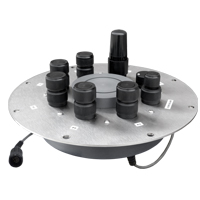 The Great Lakes region is a dynamic ecosystem that supports millions of people, plants and animals. Key to maintaining its vitality is making sure the waterways that sit at its base remain clean and healthy. To do that, scientists and water managers need steady, reliable data. They often get this information from buoy networks.
The Great Lakes region is a dynamic ecosystem that supports millions of people, plants and animals. Key to maintaining its vitality is making sure the waterways that sit at its base remain clean and healthy. To do that, scientists and water managers need steady, reliable data. They often get this information from buoy networks.
There are many different Great Lakes buoy networks out there, which are largely supported by government agencies and universities. Maintaining these networks, including servicing old buoys or launching new ones, is a big and important job.
In one example of the ongoing work to support buoy networks, researchers with the University of Wisconsin launched two new monitoring buoys to track a variety of water quality parameters. The new platforms contribute data to the National Data Buoy Center, Great Lakes Observing System (GLOS) and the University of Michigan’s Ocean Engineering Lab.
Buoy network watches water quality
Given the incredible wave action that is possible on the Great Lakes, it was necessary to obtain buoys with enough buoyancy to support the expensive sensors and monitoring equipment involved with the project. That’s why scientists at the University of Wisconsin chose two NexSens Technology CB-1250 Data Buoys. Not only does their hefty construction make them the most ideal choice for standing up to conditions in the Great Lakes, it also supports a massive instrument well, passthrough holes for sensors and large 65-watt solar panels for power.

Within each buoy’s instrument well is a robust NexSens X2-CB Buoy Data Logger that collects information from sensors and broadcasts it via cellular telemetry to researchers onshore. On the topside, both CB-1250s are equipped with Lufft WS501 Multi-Parameter Weather Sensors that track air temperature, humidity, barometric pressure, solar radiation and wind speed and direction. Mounted close to these are solar-powered marine lights that act as beacons during the nighttime to warn boaters where the buoys are located.
Beneath the buoys, deployed securely in passthrough holes, are Nortek Aquadopp Acoustic Doppler Current Profilers. These small and lightweight profilers are built specifically to study currents within 100 meters’ range. Measurements they collect on the internal waves of the Great Lakes are useful for researchers who use the data in long-term circulation models, studying nutrient transport and even in models studying the global climate.
Also deployed on the bottom side are NexSens AccuStage Absolute Water Level Sensors. These are configured to sample at a rapid rate, collecting level measurements many times per second, to calculate data on wave action that are useful to boaters, swimmers and recreational fishermen. Each CB-1250 also has a string of NexSens T-Node Temperature Sensors that capture a temperature profile of the lake.
All sensor data logged by the X2-CB Buoy Data Loggers are transmitted using cellular telemetry to scientists at the University of Wisconsin who view them on a computer running NexSens iChart software. They are then uploaded via internet to the various buoy networks they contribute to, making it possible for government agencies and private citizens basin-wide to access their findings.
The CB-1250 offers increased flotation and solar charging for heavy or power-hungry sensors while still maintaining a relatively small footprint.
The X2-CB is a fully featured data logger housed inside a waterproof enclosure specifically designed to integrate with NexSens’ CB-Series data buoys.
The Lufft WS501 Multi-Parameter Weather Sensor integrates the Kipp & Zonen CMP 3 pyranometer along with sensors for air temperature, humidity, pressure, solar radiation & wind.
The NexSens T-Node FR thermistor string provides high precision temperature measurement in an addressable and connectorized assembly.




